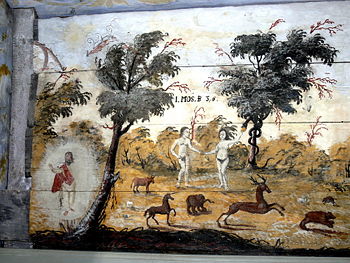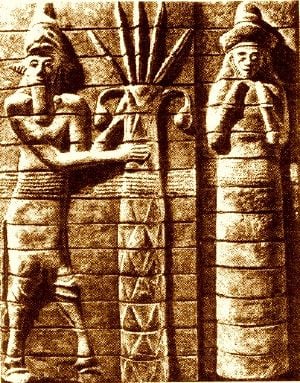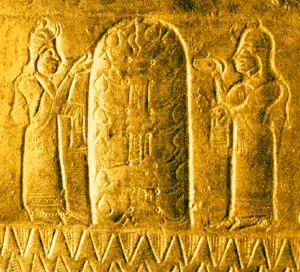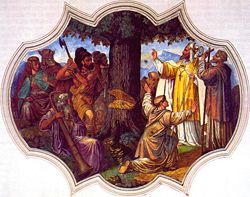Tree of Life (Judeo-Christian)

The Tree of Life is a universal symbol found in many religious traditions around the world, including Judaism, Christianity, and several other religions and mythologies. It is sometimes associated with The World Tree, which is represented as a colossal tree that connects the heavens, the earth, and, through its roots, the underground.
In the Old and New Testaments, it is a sacred symbols that is mentioned in the Book of Genesis, the Book of Proverbs, and the Book of Revelations. It is also a major symbol in the tradition of Kabbalah, or Jewish mysticism, and also part of the apocryphal writings.
Tree of Life in the Bible
Genesis
According to Gen. 2.9, there stood in the Garden of Eden with Adam and Eve a "Tree of life" and the "Tree of Knowledge of Good and Evil." Adam and Eve, the ancestors of humankind, were told by God not to eat of the Tree of Knowledge of Good and Evil lest they would die. Both were naked, but were unashamed. A serpent challenged Eve about eating from the Tree of Knowledge of Good and Evil, often symbolized in European art and literature as an apple tree:
"The serpent said to the woman, ‘You will not die; for God knows that when you eat of it your eyes will be opened, and you will be like God, knowing good and evil.' When the woman saw that the tree was good for food, and that it was a delight to the eyes, and that the tree was to be desired to make one wise, she took of its fruit and ate; and she also gave some to her husband, who was with her, and he ate. Then the eyes of both were opened, and they knew that they were naked; and they sewed fig leaves together and made loincloths for themselves."
Eve ate of the the fruit, and she then persuaded Adam to eat of the fruit. They then realized their nakedness and covered the lower parts of their body. Gen. 3.22 states that after Adam and Eve had eaten from the Tree of Knowledge of Good and Evil, against the command of God, they were expelled from the Garden of Eden. As punishment for his transgression, the serpent was condemned to crawl on its belly and eat dust. The woman was sentenced to the pangs of childbirth, and the man was made to toil and sweat from the hostile soil. God then barred access to the Tree of Life placing cherubim and a flaming sword at the eastern entrance to Eden.
Other biblical references
The idea of the Tree of Life appears in the Book of Proverbs four times:
- To lay hold of wisdom is to lay hold on a tree of life (Proverbs 3:18).
- The fruit of the righteous is a tree of life (Proverbs 11:30).
- A longing fulfilled is a tree of life (Proverbs 13:12).
- The tongue that brings healing is a tree of life(Proverbs 15:4).
Ezekiel projected a picture of the Messianic age when he wrote of healing trees that would draw their sustenance from waters flowing from the Temple of Jerusalem. They would provide new fruit each month. "And on the banks, on both sides of the river, there will grow all kinds of trees for food. Their leaves will not wither nor their fruit fail, but they will bear fresh fruit every month, because the water for them flows from the sanctuary. Their fruit will be for food, and their leaves for healing".(Ezekiel 47:12)
The New Testament Book of Revelation refers to the Tree of Life in three places.
- To him who who conquers I will grant to eat of the tree of life, which is the paradise of God (Revelation 2.7).
- Through the middle of the street of the city [New Jerusalem], also, on either side of the river, the tree of life with its twelve kinds of fruit, yielding in fruit each month; and the leaves of the tree were for the healing of the nations(Revelation 22:2).
- Blessed are those who wash their robes, that they may have the right to the tree of life and that they may enter the city by the gates (Revelation 22:14).
Apocryphal Writings
The Coptic Book of Enoch describes the Tree of Life as "a fragrance beyond all fragrances; its leaves and bloom and wood wither not forever; its fruit is beautiful and resembles the date-palm" (Ethiopic Enoch 24:4) The Slavonic Book of Enoch says "In the midst there is the tree of life... and this tree cannot be described for its excellence and sweet odor" (Slavonic Enoch 8:3). The Book of 2 Esdras describes the future and says "Unto you is paradise opened, the tree of life is planted" (Esdras 8:52).
Latter-day Saints tradition
In the Book of Mormon, the Tree of Life is shown to Lehi and then also to his son Nephi in a dream or vision, between 600 and 592 B.C.E. according to the Book of Mormon (1 Nephi 8:10). A later passage describes it as "exceeding of all beauty; and the whiteness thereof did exceed the whiteness of the driven snow." (1 Nephi 11:8) Nephi interprets the Tree as representing "The love of God, which sheddeth itself abroad in the hearts of the children of men; wherefore, it is the most desirable above all things."
The Tree of Life in Kabbalah
According to the teachings of the Kabbalah, the tradition of mystical Judaism, the Tree of Life is not a literal tree but a symbol that is used to understand the nature of God and the manner in which He created the world. It is also reflecting in man, who is a microcosm of the creation.
Kabbalistic tradition holds that the world was created and sustained by ten channels of Divine emanations. These channels are referred to as the ten sefirot, which are united in God as one. They are represented in a diagram or chart that is known as the Tree of Life. Kabbalistic texts further describe the sefirot as the fundamental building blocks of the world and of mankind. These emanations also represent ten characteristics of God that are knowable, as compared to those characteristics that cannot be known by humans. God is continually working in the world through these sefirot. Each emanation can combine with the other sefirot and has both a positive and negative aspect within itself.
The sefirot are sometimes described as being divided into triads, plus the tenth sefirah of Malchut, which experiences separation from the other nine. The first triad corresponds to the mind, the second three correspond to the desires of the heart, and the third three correspond to the qualities of action that bring Malchut into being.
As Kabbalah developed over a period of time, the sefirot developed various meanings, and the arrangement of these emanations as the "Tree of Life" has also been expressed in various ways.
The diagram of the kabbalistic Tree of life is typically drawn in such a way that it resembles a human body. Each of the Sefirot corresponds to one of the human organs or limbs. The Tree of Life has a right side and a left side. The right side is considered to represent God’s masculine side, and the left side represents the feminine side of God.
On the Tree of Life diagram the beginning of the universe is placed at a place above all the other sefirot. The first sefirah is called Kether, which means crown in English. It is known as the Primordial Point or the “I am.” It is also known as the infinite energy and limitless light of God. It is sometimes referred to as the Divine will, and as containing all of the other sefirot within it. It is also thought of as the link between the God's infinite world and the finite world in which we live. It is also the place that initiates the flow of each of the Sefiot as divine emanations. Moreover, the sefirot at the bottom of the Tree return to the Kether at the top, and all of the sefirot interact with each other.
The second emanation is Chochmah, which means wisdom. It is often referred to as intuition. It is created out of the pure energy of Kether and is considered to be God’s primordial masculine energy. The next sefirah, on the left side of the Tree, is Binah or Understanding, which is thought of as God’s primordial feminine energy, or the Supernal Mother of the universe. It interacts with Chochmah, and the two of them are often referred to as the Father and Mother of the Universe. They are unified as one whole and are in complete harmony. Kether, Chochmah, and Binah are called the supernal sefirot and are considered to be the primordial energies of the universe.
On some diagrams of the sefirot there is an additional emanation known as Da'at, or knowledge. Da'at is usually seen as the synthesis of Chochmah and Binah, and is a kind of reflection of Kether. Da'at is not considered one of the ten sefirot, but is a mediating and synthesizing principle between Chochmah and Binah.
On the left side of the tree is Gevurah, or Power. It is sometimes referred to as justice or law. It interacts with the sefirah of Chesed or Grace, which is on the right side of the Tree. It is described as an outgoing and expanding force and is also referred to as absolute love that knows no limitation. Chesed is the love that is free and lacking in restraint, whereas Gevurah is the love that represents discipline. Chesed and Gevurah thus represent the two major aspects of love. Chesed is gendered male because it expands. Gevurah is gendered female because it receives, encloses, and constricts. Chesed and Gevurah together operate in harmony to sustain the world. Rounding out this triad is Tiferet, which is typically drawn in the middle vertical column on the Tree, as its center. It is a combination of harmony, truth, and compassion. The triad of Chesed, Gevurah, and Tiferet are forces within the heart.
The final triad of sefirot consists of Netzach, Hod, and Yesod. The sefirah of Netzach, which is on the left side of the Tree, is the emanation of Victory and the capacity for overcoming. It is also referred to as the impulse to get things done, to work. Some texts refer to it as eternity, an aspect of revelation which stretches horizontally for all time, and an attirbute of endurance within the Divine. The sefirah of Hod, on the right side of the Tree, is known as Splendor, and is sometimes referred to as persistence or holding on. Netzach and Hod balance into Yesod, which is the capacity and desire to build bridges or make contacts, or the ability to establish relationships.
The last of the ten Sefirot on the Tree is Malchut, which is the summation and culmination of all the Sefirot that are above it. It completes the chain of the sefirot, representing the world of experience, that aspect of the Divine which is totally immanent, here and now
Tree of Life in other traditions
Pre-Judaic mythology

The symbol of the Tree of Life predates the Judeo-Christian tradition and is found in many cultures throughout the world. In ancient Mesopotamian and Canaanite tradition, the tree was often associated with a goddess and fertility, or with a male and female god together.
In the story of Inanna and the Huluppu Tree, the goddess Ishtar/Inanna plants this sacred tree in her garden, where it is guarded by the "snake which knows no charm." In the Epic of Gilgamesh the hero searches for the secret of eternal life and learns that a plant which grows at the bottom of the sea can rejuvenate the person who consumes it. After retrieving it, however, the plant is stolen and consumed by a serpent.
The Assyrian Tree of Life was represented by a series of nodes and crisscrossing lines. It was an important religious symbol among these peoples, often attended to by Eagle-Headed Gods and Priests, or the King himself.
In ancient Armenia around twelfth to sixth century B.C.E., the Tree of Life was has been found drawn onto the exterior walls of fortresses and carved on the armor of warriors. The branches of the tree were equally divided on the right and left sides of the stem, with each branch having one leaf, and one leaf on the apex of the tree. Servants stood on each side of the tree with one of their hands up as if tending it.
In Egyptian mythology, Isis and Osiris were said to have emerged from the acacia tree of Saosis, which the Egyptians referred to it as the "tree in which life and death are enclosed." The Egyptian's Sycamore fig was also considered as a sacred tree which stood on the threshold of life and death, connecting the two worlds.
=Pagan traditions

In Germanic paganism, trees played a prominent role, appearing in various aspects of surviving texts and possibly in the name of gods. The tree of life appears in Norse religion as Yggdrasil, the world tree, a massive tree—sometimes considered a yew or ash tree—with extensive lore surrounding it. Examples include Thor's Oak, sacred groves, the Sacred tree at Uppsala, and the wooden Irminsul pillar. In Norse Mythology it is the apples from Iðunn's ash box that provides immortality for the gods. Christian saints such as Saint Boniface are sometimes described as destroying these sacred trees as objects of pagan idolatry.
Other traditions
Among pre-Columbian Mesoamerican cultures, the concept of "world trees" is a prevalent motif. World trees embodied the four cardinal directions, which represented also the fourfold nature of a central world tree, a symbolic axis mundi connecting the planes of the Underworld and the sky with that of the terrestrial world. Depictions of world trees are found in the art and mythological traditions of cultures such as the Maya, Aztec, Izapan, Mixtec, Olmec, and others, dating to at least the Mid/Late Formative periods of Mesoamerican chronology. World trees are frequently depicted with birds in their branches, and their roots extending into earth or water, sometimes atop a "water-monster," symbolic of the underworld).
In China, an archaeological discovery in the 1990s unearthed a sacrificial pit at Sanxingdui dating from about 1200 B.C.E. It contained three bronze trees, one of them four meters high. At the base was a dragon, and fruit hung from the lower branches. At the top is a strange bird-like (phoenix) creature with claws. Also from Sichuan, from the late Han dynasty (c 25 – 220 C.E.) is another tree of life guarded by a horned beast with wings. The leaves of the tree are coins and people. At the apex is a bird with coins and the Sun. There is also a Taoist story of a tree that produces a peach every three thousand years. The one who eats the fruit receives immortality.
ReferencesISBN links support NWE through referral fees
- Epstein, Perle. Kabbalah, the Way of the Jewish Mystic Boston, MA: Shambhala Publications, Inc. (1978) pp. 69-72. ISBN 0877734380
- Encausse, Gerard (Papus). The Qabalah: Secret Tradition of the West York Beach, ME: Samuel Weiser, Inc. (2000) pp. 83-4. ISBN 0877289360
- Fortune, Dion. The Mystical Qabalah. York Beach, ME: Samuel Weiser, Inc. (2000) ISBN 1578631505
- Malachi, Tau. Gnosis of the Cosmic Christ. A Gnostic Christian Kabbalah St. Paul, MN: lewellyn Publications. (2005) ISBN 738705918
- Regardie, Israel. The Tree of Life: An Illustrated Study in Magic St. Paul, MN: Llewellyn Publications. (2000) ISBN 1-56718-132-5
| Kabbalah Portal |
External links
Jewish and Non-Jewish views
- Colin Low's Notes on Kabbalah - The Tree of Life
- Basic Hermetic Qabalah (byzant.com)
- Tree of life symbolism according to Archeosophy
- Donmeh West
- Kheper's Kabbalah Page
- Work of the Chariot
- Geocities Page
- The Isometric Sephiroth: The Forgotten Correspondences
- Etz Hhaim: The Tree of Life: The Original Tree of the Sepher Yetsira
- Velázquez - La Kabala y Las Meninas





